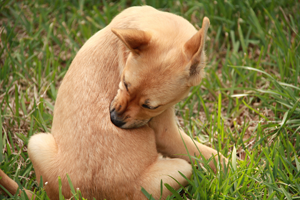Pets and Allergies
 One of the most frustrating medical problems for both vets and owners is pet allergies. The most common seen in pets are what we call the "Big Three":
One of the most frustrating medical problems for both vets and owners is pet allergies. The most common seen in pets are what we call the "Big Three":
 One of the most frustrating medical problems for both vets and owners is pet allergies. The most common seen in pets are what we call the "Big Three":
One of the most frustrating medical problems for both vets and owners is pet allergies. The most common seen in pets are what we call the "Big Three":
(or Food Hypersensitivity)
Food hypersensitivity is a skin disorder of dogs and cats caused by an allergic reaction to food. The condition can occur at any time of the year, and the reaction can be immediate (within minutes to a few hours after eating) or delayed (within several hours to days). Most affected pets have eaten the offending material for over 2 years.
Skin reactions include redness, crustiness, and pustules (pimples). Many cases are complicated by bacterial infection and other skin disorders. In some cases, digestive disturbances also accompany the skin condition.
Diagnosis of food hypersensitivity is difficult and requires feeding a hypo-allergenic diet and gradually adding and deleting foods suspected of causing a reaction.
1. When the offending material can be identified, the outlook for control is excellent.
2. When the causative material is not known or a non-allergenic diet cannot be fed, anti-inflammatory drugs are the best treatment. Usually this type of therapy is lifelong.
Signs of flea-bite allergy result from hypersensitivity (allergy) to flea saliva. In an allergic dog, the bite of a single flea may cause a serious problem. Extensive skin damage may result from the pet's biting, licking, and scratching. Although flea-bite allergy can be treated, it often recurs because flea eggs may hatch up to 1 year after being deposited in the environment. Most of the flea’s life cycle occurs off the pet. Your pet’s environment may be contaminated with fleas, and even an occasional flea bite can trigger the allergic reaction.
Flea allergies are most troublesome in the summer and fall in areas with cold winters and warm summers. In warm climates or in heated flea-infested houses, flea allergy may occur throughout the year.
In dogs, the main signs of flea allergy are excessive hair loss and severe scratching and biting. Skin sores develop primarily around the base of the tail, in the middle of the back, and on the abdomen. Skin infections are common. Dogs generally respond well to treatments such as antihistamines, medicated shampoos, topical flea control, and antibiotics if needed. In severe cases, cortisone therapy may be recommended.
In cats, the main signs of flea allergy are also excessive hair loss and severe scratching and biting. Skin sores develop primarily around the base of the tail, in the neck area, and on the abdomen. They can sometimes form red, inflammed plaques, also called eosinophilic granulomatous complex. Skin infections are common. Most cats respond very well to cortisone injections, topical flea control, and antibiotics if needed.
1. Flea allergies usually worsen as animals age. Signs may begin earlier in the flea season and last longer. Also skin reactions generally become more severe.
2. Treatment includes flea control on the pet and in the environment and suppression of the allergic reaction. Occasionally desensitization of the dog is attempted.
3. Desensitization (“allergy shots”) to flea saliva is controversial. In some cases, good results are achieved, while other dogs fail to respond. The doctor will discuss the advisability of desensitization for your dog.
(also called Allergic Inhalant Dermatitis, or Atopy)
Atopy is an intensely itchy skin condition caused primarily by inhaled allergens, such as molds, pollens, and dust. Occasionally atopy results from allergens that are absorbed through the skin or eaten. Dogs with atopy are genetically predisposed to the condition, and certain breeds, such as Schnauzers, Irish Setters, Boston Terriers, Scottish Terriers, West Highland White Terriers, Cairn Terriers, and Wire-Haired Terriers, are more commonly affected than other breeds. Female dogs are more likely to be affected than males. Atopy usually first occurs at 1 to 3 years of age.
Atopy may be seasonal or nonseasonal, but most dogs with atopy eventually have nonseasonal signs. About 75% of atopic dogs first develop signs from spring to fall.
Itching is the main sign of atopy. Chewing, scratching, and bacterial infection damage the skin. The face, feet, and abdomen are usually the first areas affected. Besides skin problems, other signs, such as a runny nose, asthma, cataracts, and urinary and gastrointestinal disorders, occasionally occur.
1. Skin and blood tests may be recommended to assist in identifying the cause of the allergy. The doctor will advise you if either of these types of tests are necessary.
2. Keeping your dog away from the cause of the allergy is not always practical or possible. When the cause is known and avoidance is possible, this is the best means of atopy control.
3. Treatment with antihistamines and/or anti-inflammatory drugs is often the most effective means of controlling atopy. In some dogs, however, these drugs become less effective as time passes, and may cause undesirable side effects.
4. Desensitizing injections (“allergy shots”) may help if avoidance or drug therapy is ineffective. Desensitization, however, is not always effective, and continued treatment is usually necessary.
5. Regular bathing and grooming frequently help control atopy.
6. Most dogs respond very well to fatty acid supplements that contain Eicasapentanoic Acid (EPA), which is found to be deficient in most atopic dogs.